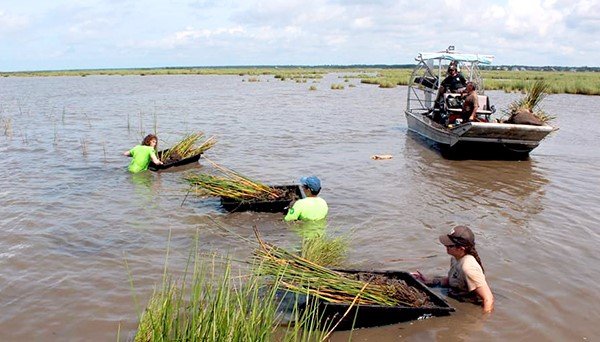Marsh Restoration in Grand Bayou Indian Village, Plaquemines Parish, Louisiana
How a village is building resilience to floods, sea level rise and land loss
Why Climate Resilience Is Important to Grand Bayou Indian Village
In the past several decades, Grand Bayou Indian Village has lost a significant amount of shoreline due to a combination of erosion, land subsidence and sea level rise. Many Atakapa-Ishak/Chawasha tribal members live in Grand Bayou Indian Village. Rising sea levels and increased shoreline erosion are stripping the community of essential defenses against stronger storm surges and the resultant flooding. It is costly to rebuild and repair flood damage. Further impacts include the loss of vital economic, cultural and social resources along the shoreline, such as habitat for staple food sources and valuable Gulf shrimp. In addition, because Grand Bayou is outside the State of Louisiana’s levee system and the Atakapa-Ishak/Chawasha tribal community lacks federal recognition, it does not have access to resources that would otherwise enable the community to become more resilient to these stresses. To adapt to these challenges the Village has undertaken a revegetation program to replant marsh grass to help stabilize the shoreline and develop natural flood prevention defenses.
Partnerships and Project Goals
To mitigate the impacts of coastal land loss and climate hazards, the Grand Bayou Indian Village and its partners – Common Ground Relief, the Coastal Re-Vegetation Program of the Louisiana Department of Agriculture and Forestry, and the First People’s Conservation Council of Louisiana – worked together to restore marsh land and native marsh grasses. Leveraging around $100,000 awarded from the EJ4Climate Grant Program, Village members and Common Ground Relief drew upon Village members’ expertise and knowledge to restore and protect lost shorelines by planting 6,000 plugs of smooth cordgrass, a salt-resistant native marsh grass, ultimately restoring 2.5 miles of shoreline over two years.

The First Peoples' Conservation Council was a key partner in fostering the relationships between Common Ground Relief and Village members. The Louisiana Department of Agriculture and Forestry assisted with the creation of planting maps by providing data on historical land elevation and water depths, salinity rates, tidal flow, and advice on species selection.
Marsh grass planting will help reclaim flooded areas, build resilience to coastal storms, and sequester and store carbon. Village members plan to continue planting plugs of smooth grass over the long term to build on this project.
Adaptation in Action
Village members are engaged in ongoing discussions with planting partners and local, state, and federal agencies to address the longer-term impacts of coastal hazards and historic environmental racism. Village members are in the process of launching a locally led digital media storytelling project about the history of land loss and coastal hazards in Grand Bayou Indian Village and the role of shoreline restorations as a viable sustainable solution for the future. These collective efforts are already making Grand Bayou Indian Village more resilient by being better protected against intensifying storms and creating stronger community bonds.
